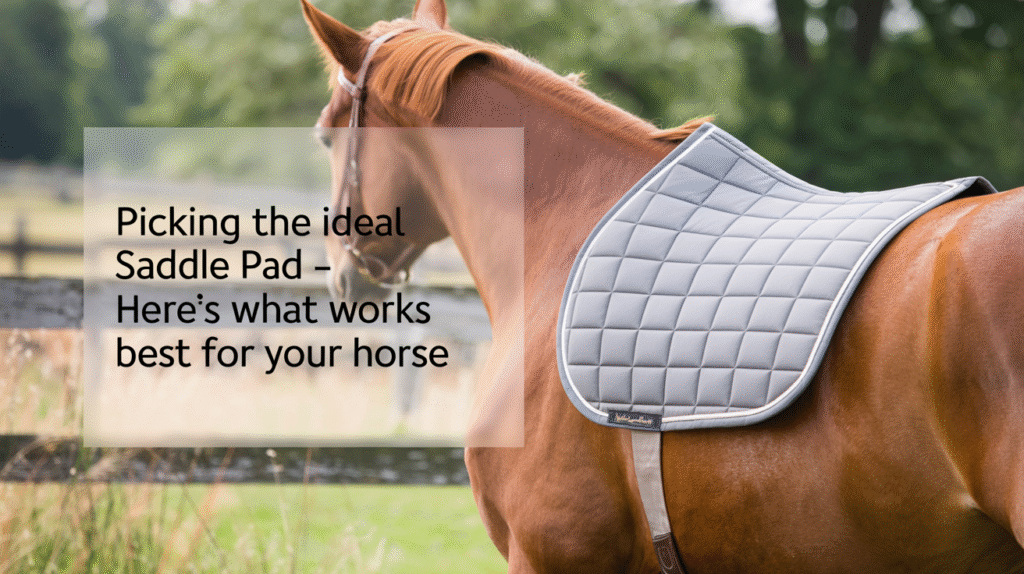The best saddle pad is one that fits your horse’s shape, supports your saddle type, and provides adequate cushioning without creating pressure points. It’s more than just a layer of fabric — the right saddle pad improves saddle fit, protects the horse’s back, and helps wick away moisture. Whether you’re a trail rider, a dressage enthusiast, or someone training daily, selecting the correct pad directly impacts performance and comfort.

Let’s dive into how to pick the ideal saddle pad for your specific needs.
Why the Right Saddle Pad Matters
A properly chosen saddle pad enhances your horse’s comfort and prevents long-term issues related to poor saddle fit or sweat accumulation.
Ensures Better Saddle Fit
Saddle pads fill in minor gaps, allowing better contact and reducing pressure.
- Balances uneven saddles: Helps adjust small fit discrepancies.
- Prevents rocking or slippage: Keeps the saddle stable and secure.
Protects the Horse’s Back
Pads act as a cushion and moisture barrier.
- Absorbs shock during riding: Reduces strain on the spine and withers.
- Wicks sweat away: Keeps the horse’s back dry and comfortable.
Types of Saddle Pads and Their Uses
Different pad types suit different disciplines and saddle styles.
All-Purpose Pads
These are commonly used across various riding styles.
- Versatile and moderately padded: Ideal for casual riding and general use.
- Square-shaped or contoured: Covers a broad range of saddle fits.
Dressage Pads
Designed specifically for the straight flap of dressage saddles.
- Longer drop length: Matches the vertical shape of dressage saddles.
- Minimal bulk: Allows close contact with the horse for precise cues.
Jumping or Close Contact Pads
Made for forward-cut saddle flaps used in jumping disciplines.
- Shorter length in the back: Prevents interference during jumps.
- Thin and shaped: Provides support without restricting movement.
Western Saddle Pads
Thicker and broader to match the build of Western saddles.
- Heavy padding: Suitable for long rides and added weight.
- Wool or felt materials: Provide strong shock absorption and breathability.
Correction Pads
Equipped with inserts or shaping to correct saddle fit issues.
- Adjustable shims: Can be repositioned to fix balance issues.
- Used temporarily or for growing horses: Great for horses with changing musculature.
Materials: What Your Saddle Pad Should Be Made Of
Material plays a key role in comfort, moisture control, and durability.
Wool or Felt
Natural, breathable, and great for daily use.
- Excellent moisture-wicking: Keeps the horse’s back dry.
- Forms to the horse’s shape over time: Custom fit with repeated use.
Cotton
Soft and easy to clean but less durable.
- Best for casual use or sensitive horses: Soft against the skin.
- Requires more frequent washing: Absorbs sweat quickly but can retain it.
Gel and Foam Inserts
Provide advanced shock absorption.
- Help with pressure relief: Especially in high-stress areas.
- Ideal for jumpers or horses with sensitive backs: Absorbs sudden impact.
Neoprene or Synthetic
Durable and easy to maintain, though less breathable.
- Easy to wipe down: Great for muddy or wet environments.
- May cause sweat buildup: Less suited for hot climates.
How to Choose Based on Your Horse’s Needs
Every horse is unique, so it’s important to match the pad to their anatomy and your activity level.
Fit and Conformation
A pad must conform to your horse’s back, especially around the withers and spine.
- High-withered horses: Use cut-out or contoured pads to relieve pressure.
- Round-backed horses: Use pads with non-slip backing to reduce saddle movement.
Riding Discipline
Different styles of riding place different demands on the pad.
- Jumping and eventing: Use breathable, thin pads with impact protection.
- Dressage: Look for shape-retaining pads with minimal bulk.
- Trail riding or endurance: Opt for long, thick pads for extended support.
Saddle Pad Maintenance Tips
Taking care of your pad helps keep your horse comfortable and extends pad life.
Cleaning Guidelines
Pads must be cleaned regularly to avoid skin irritation and odor.
- Wash cotton and synthetic pads weekly: Use mild detergent and hang dry.
- Brush or vacuum wool pads: Avoid soaking them, as it may damage the fibers.
Storage Advice
Improper storage can deform your pad or introduce mold.
- Store flat or over a saddle rack: Prevents curling or creasing.
- Keep in a dry, well-ventilated area: Protects from mildew and bacterial growth.
FAQs
Here are some questions and answers about picking the ideal saddle pad:
How do I know if my saddle pad fits correctly?
The pad should cover the entire area under the saddle without extending excessively. It should not interfere with the horse’s shoulder movement or bunch up under the saddle.
What is the best saddle pad for a sensitive-backed horse?
Pads with memory foam, gel inserts, or natural wool are often best. They conform well to the horse’s shape and provide extra cushioning.
How often should I replace my saddle pad?
Replace pads when they become permanently compressed, torn, or if they no longer offer adequate cushioning. This typically occurs after a few years of regular use.
Can I use a Western pad with an English saddle?
No. Western pads are larger and bulkier, which can create an unstable or uncomfortable fit for English saddles. Always match the pad style to the saddle type.
Are thicker saddle pads always better?
Not necessarily. While thickness adds cushioning, it can also change saddle fit and cause pressure points. Choose padding based on your horse’s anatomy and the condition of the saddle.
Choosing the right saddle pad improves not just comfort and safety but also the overall riding experience. With the proper fit, material, and maintenance, you can keep your horse’s back protected and healthy ride after ride.